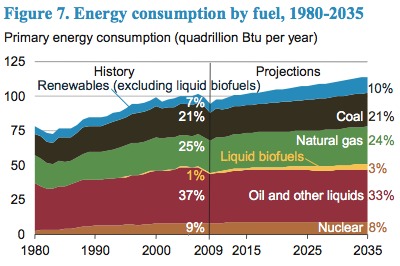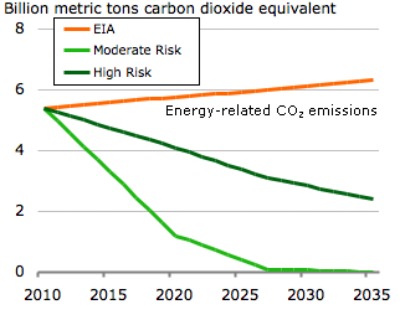Cross-posted from the Wonk Room.
The U.S. Energy Information Administration (EIA) has projected that the United States will lead the world into catastrophic global warming over the next twenty five years. In its 2011 Annual Energy Outlook, the EIA predicts that energy-related CO2 emissions will “grow by 16 percent [PDF] from 2009 to 2035,” reaching 6.3 billion metric tons of carbon dioxide equivalent (or 1.7 GtC):

The fuel mix the EIA projects remains predominantly coal and oil, with a moderate rise in renewable energy, whose pollution benefits are offset by growth in energy demand:

This pathway would almost certainly commit the world to catastrophic climate change, including rapid sea level rise, extreme famine, desertification, and ecological collapse on land and sea. Right now, the United States, with less than five percent of global population, produces 20 percent of global warming pollution. Center for American Progress senior fellow Joe Romm published in Nature in 2008 that humanity “must aim at achieving average annual carbon dioxide emissions of less than 5 GtC [5 billion metric tons of carbon, or 18 billion metric tons of carbon dioxide] this century or risk the catastrophe of reaching atmospheric concentrations of 1,000 parts per million.” To do so, he said, humanity needs to adopt a “national and global strategy to stop building new traditional coal-fired plants while starting to deploy existing and near-term low-carbon technologies as fast as is humanly possible.”
Since 2008, the science has grown more dire. The impact of existing global warming on oceans, extreme weather, agriculture, polar ice, and ecosystems is at or exceeding the highest range of past projections. Dr. Romm’s suggestions were based on the assumption that stabilizing greenhouse gas concentrations at 450 parts per million (ppm) would likely limit warming to 2°C above pre-industrial temperatures. However, as climate scientists Kevin Anderson and Alice Bows write in Philosophical Transactions of the Royal Society, “the impacts associated with 2°C have been revised upwards, sufficiently so that 2°C now more appropriately represents the threshold between ‘dangerous’ and ‘extremely dangerous’ climate change”:
There is now little to no chance of maintaining the rise in global mean surface temperature at below 2°C, despite repeated high-level statements to the contrary. Moreover, the impacts associated with 2°C have been revised upwards, sufficiently so that 2°C now more appropriately represents the threshold between dangerous and extremely dangerous climate change.
Over a year and a half ago, Dr. Michael Mann concurred in Proceedings of the National Academy of Sciences that the 450 ppm target is “terribly risky“:
So regardless of one’s precise definition of dangerous anthropogenic interference, stabilizing greenhouse gas concentrations much above 450 ppm CO2eq would be a terribly risky prospect.
Friends of the Earth UK’s latest report, “Reckless Gamblers,” reflects the science in its recommendations for immediate and significant cuts in climate pollution, while admitting that there are significant global-scale risks that come even with that effort. If future pollution is distributed on a per-capita basis, then net United States emissions would need to go to zero by 2030 (a similar effort by top climate institutes finds the US pathway goes to zero by 2020 [PDF]). Comparing the EIA pathway for energy-related CO2 emissions — which represent about 83 percent of total US greenhouse pollution — to the range of merely dangerous emissions pathways:

Unfortunately, the economics that policymakers rely upon is grossly outdated. Even as climate scientists have stopped considering 450 ppm stabilization safe, economists still question whether there would be any significant climate damage in a 550 ppm world (or even a 1000 ppm world). Economist Simon Dietz recently found that the risk of continent-scale economic disaster in a 550 ppm scenario is only six percent — and that’s dramatically higher than previous economic work. Based on his unreasonably sunny scenarios, he estimates that the “social cost of carbon” — essentially how current pollution should be taxed — is around $300/tCO2. And that’s dramatically higher than the official U.S. government estimates.
Suffice it to say our prospects for avoiding catastrophic loss caused by our damaged atmosphere are not improved by a political system in thrall to fossil fuel polluters. Hope for a sustainable future lies in our nation’s ability to overcome the fear of changing our disastrous status quo and conquer the great challenges ahead.



